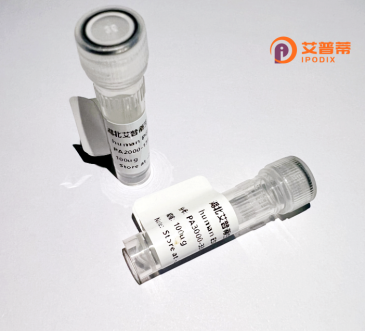
| 纯度 | >90%SDS-PAGE. |
| 种属 | Human |
| 靶点 | CEP120 |
| Uniprot No | Q8N960 |
| 内毒素 | < 0.01EU/μg |
| 表达宿主 | E.coli |
| 表达区间 | 1-380aa |
| 氨基酸序列 | MVSKSDQLLIVVSILEGRHFPKRPKHMLVVEAKFDGEQLATDPVDHTDQPEFATELAWEIDRKALHQHRLQRTPIKLQCFALDPVTSAKETIGYIVLDLRTAQETKQAPKWYQLLSNKYTKFKSEIQISIALETDTKPPVDSFKAKGAPPRDGKVPAILAGLDPRDIVAVLNEEGGYHQIGPAEYCTDSFIMSVTIAFATQLEQLIPCTMKLPERQPEFFFYYSLLGNDVTNEPFNDLINPNFEPERASVRIRSSVEILRVYLALQSKLQIHLCCGDQSLGSTEIPLTGLLKKGSTEINQHPVTVEGAFTLDPPNRAKQKLAPIPVELAPTVGVSVALQREGIDSQDAFWYSALDIIFPLFIFLFLVLDAIRKFANYEEK |
| 分子量 | 69.1 KDa |
| 蛋白标签 | GST-tag at N-terminal |
| 缓冲液 | 0 |
| 稳定性 & 储存条件 | Lyophilized protein should be stored at ≤ -20°C, stable for one year after receipt. Reconstituted protein solution can be stored at 2-8°C for 2-7 days. Aliquots of reconstituted samples are stable at ≤ -20°C for 3 months. |
| 复溶 | Always centrifuge tubes before opening.Do not mix by vortex or pipetting. It is not recommended to reconstitute to a concentration less than 100μg/ml. Dissolve the lyophilized protein in distilled water. Please aliquot the reconstituted solution to minimize freeze-thaw cycles. |
以下是关于重组人CEP120蛋白的3篇文献概览,供参考:
---
1. **文献名称**:*CEP120 interacts with dynactin and regulates microtubule dynamics during ciliogenesis*
**作者**:Wang L., et al.
**摘要**:研究发现重组CEP120蛋白与动力蛋白复合体dynactin相互作用,通过调控微管稳定性促进纤毛形成。实验表明,CEP120缺失会导致纤毛组装缺陷,影响细胞周期进程。
---
2. **文献名称**:*Structural and functional analysis of CEP120 reveals its role in centriole duplication*
**作者**:Gönczy P., et al.
**摘要**:通过X射线晶体学解析了重组CEP120蛋白的N端结构域,发现其通过与C2CD3蛋白结合调控中心体复制。功能实验证实CEP120突变可导致小鼠胚胎发育异常。
---
3. **文献名称**:*CEP120 mutations cause Joubert syndrome by disrupting cilia-associated signaling pathways*
**作者**:Shaheen R., et al.
**摘要**:临床研究发现,CEP120基因突变与Joubert综合征(一种纤毛相关神经发育疾病)相关。重组CEP120蛋白功能实验表明,突变体破坏了Hedgehog信号通路,导致神经元迁移缺陷。
---
**扩展方向**:CEP120的研究多聚焦于其在纤毛发生、中心体复制及发育疾病中的作用,后续可关注其在癌症(如异常细胞分裂)或药物靶点开发中的潜在价值。
CEP120 (Centrosomal Protein 120) is a conserved centrosome-associated protein critical for centriole duplication, microtubule organization, and ciliogenesis. Encoded by the *CEP120* gene in humans, it localizes to the distal ends of parental centrioles and plays a dual role in regulating centriole length and recruiting downstream components essential for proper centrosome amplification. During cell division, CEP120 ensures spindle positioning and symmetrical cell division by interacting with proteins like CPAP and SPICE1. Its dysfunction is linked to primary microcephaly, Joubert syndrome, and other ciliopathies due to impaired centriole biogenesis or disrupted ciliary signaling.
Recombinant human CEP120 protein is typically produced in bacterial or mammalian expression systems, often fused with tags (e.g., GST, His-tag) for purification and detection. Researchers utilize it to study centrosome dynamics, cilia formation, and disease mechanisms. Structural analyses (e.g., cryo-EM) of recombinant CEP120 have clarified its role in bridging centriolar microtubules and scaffolding proteins. It also serves as a tool for screening therapeutic candidates targeting centrosome-related disorders. Its standardized production enables functional assays, antibody development, and exploration of mitotic errors in cancer or developmental defects.
×